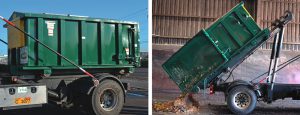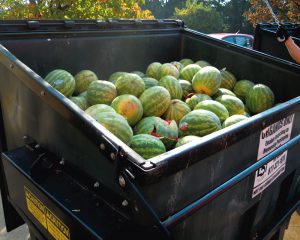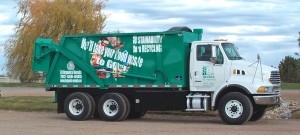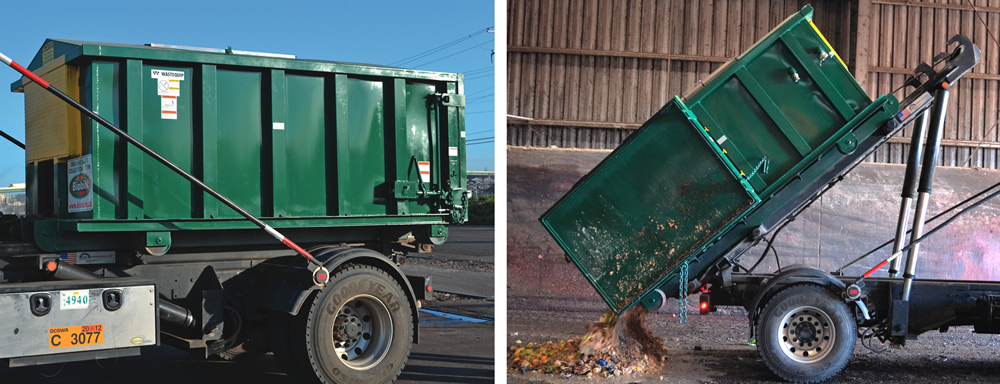Food waste is heavy and liquefies quickly, two characteristics that help determine the optimum containers for diversion programs.
Nora Goldstein
BioCycle July 2012, Vol. 53, No. 7, p. 34

Wastequip’s Organics2Go program includes a roll-off bin (left) with a patented biofiltration system to keep organic waste aerobic until it is hauled to the transfer station or processing facility (right).
When Walmart rolled out its program to divert food waste from all of its stores in the U.S. in 2010, one of the first steps was to remove one of the trash compactors behind the stores and replace it with smaller containers. That reduced the expense of having the second compactor, and created room for the organics bins. “Many of the vendors servicing the stores started out with 6- and 8-cubic yard (cy) containers, then realized that because of the weight, a 3-cy bin is more ideal,” recalls Robin Sweere of Sweere Consulting, who previously worked to develop a top retailer’s nationwide food recycling program and infrastructure. “Food waste can weigh over 1000lbs/cy in a container over 3 cy due to the compaction effect.”
The weight of food waste affects program design, from points of collection within the generators’ facility — departments in grocery stores, kitchens and serving areas in restaurants and cafeterias — to actually emptying the bins into the outside storage containers. “When you are looking at 5 lbs/gallon, a 96-gallon wheeled cart weighs 480 lbs,” says Brantley. “We don’t recommend anything larger than a 64-gallon cart, and it should be on casters so you have 4 wheels to roll it around. For a 2-wheel cart, we don’t recommend anything larger than 32- or 48-gallon. And the carts should be well-sealed because the contents will slosh around and can spill out.”
Because of the weight, generators and their vendors need to consider having a lifter to empty the “inside carts” once they are on the loading dock or at the back of the store. “Frequently, the lifter gets left out of the equipment order because of the added expense,” says Brantley. “This is where worker safety has to be considered.”
Another factor when selecting containers is if organics other than food waste — wet and/or waxed corrugated, soiled paper — are going to be included in the diversion program. Some grocery stores including only food waste can be serviced by a tote-based program (for inside collection and outside storage). Others may still prefer to empty the wheeled carts into 2 to 3 cy outside containers. Stores including cardboard and other paper streams typically require larger containers.
Wastequip recently partnered with BiobiN North America to provide another container/collection option in its Organics2Go program, a systems-based solution that includes specially designed carts and containers for collecting, transporting and storing heavy, wet organic waste. The BiobiN uses a patented biofiltration system to keep organic waste aerobic by circulating filtered air throughout the container via a series of pipes. The air is pulled through its biofiltration system and back into the container. It is available in roll-off models (from 10-25-cy), or in route collection models that can be serviced by trucks with both rear and front load configurations (sizes ranging from 2-3 cy). The aeration floor is designed to keep the food waste aerobic until the bin is serviced. “Six weeks is the longest some clients go, but frequency of service depends on the volume,” says Brantley. In some states and locales, regulations specify collection frequency, e.g., every 48 hours in California.
The WaWa convenience store chain in the mid-Atlantic region is using the BiobiN at some of its locations. “What we’ve found is that the design of the actual building can accommodate the roll-off model, but the hauler can’t get back to where the container is with the roll-off truck,” says Brantley. “In those cases, we are using the front-load model.” WaWa stores using the aerated containers are serviced about every 2 weeks.
Outside food waste containers with wheels should be kept on a concrete surface, as the weight of the container will cause it to sink on asphalt, preventing it from rolling. Containers not on wheels can be moved to the collection truck with a pallet jack, notes Sweere.
Leaks, Locks, Lids And Other Insights

For supermarkets, adjusting collection frequency or adding more containers during watermelon season can save on the expense of emergency pick-ups.
Additional tips and insights from these program design experts include:
Leak and Sloshing Test: Consider conducting a water test before using the container for the first time. Water is the densest liquid that can be put in a container, so will identify leaks quickly. Using water also is helpful to indicate how high the bin can be filled without sloshing, as well as to test out the weight on the truck’s lifting arm.
Lids and Locks: Containers with casters drilled into the unit to hold them in place can be prone to leaking. One container manufacturer makes a line of heavy-duty polyethylene front-load organics containers (Duraplast) with side pockets and casters that are not bolted through the body, thus preventing leaks. The lids have a lip that extends over the sides of the top, which enables it to stay tightly closed even if warping happens. This contains odors and keeps out vectors that sometimes can get in the bin even if the lid is locked. Food waste bins should stay locked when not being filled or emptied to prevent contamination and minimize liability (from food being removed and consumed).
Inspect the Load, Lock Down the Lid: Before the driver unloads the containers, the contents should be examined for contamination. A traditional hauler may not be accustomed to building that time in per stop, but it is critical to maintaining the quality of the entire load on the truck. Having containers where the lids can be secured in place while unloading prevents spraying of the liquid (from the lid flapping as the container is lifted and tilted) on the walls of the store and in the parking lot. Some trucks also are equipped with flaps that prevent splashing when the containers are being emptied.
Color Consistency: Using the same color bins and containers for a generator’s food waste diversion program helps standardize the program and assists with employee and hauler training.
Adjusting Based on Seasonality: Watermelons and pumpkins. Ask veterans of food waste programs at grocery stores about lessons learned, and the conversation often turns to watermelon “overload” in the summer and pumpkin overload in the fall, e.g., when stores either over-purchase or when inventory spoils more quickly than anticipated. At the end of the first year of a program, look at when stores had the highest frequency of emergency pick-ups, i.e., when haulers had to make additional (and typically more expensive) service calls to empty containers. Savings may be realized by either planning to increase collection frequency during those weeks of the year, or having additional containers dropped off in anticipation. And the upside is that many stores ultimately save by improving inventory management.

Martel Welding manufactures truck bodies specifically for food waste collection that can service totes as well as 1- and 2-cy boxes.
Martel Welding & Sons manufactures truck bodies specifically designed for food waste collection. Its rear-load trucks can service totes ranging from 32- to 96-gallons. The back bucket on the truck is used to unload the totes. The trucks also can be customized to service 1 and 2-cubic yard (cy) boxes. Truck bodies are manufactured in lengths from 15- to 24-feet, with capacity ranging from 17 cy up to 32 cy. They have a sealed tailgate and are watertight. “We were the first ones to build this type of truck body 48 years ago,” says Rick Martel, “primarily for rendering collection. Essentially, we took that design and modified it for food waste collection.”










